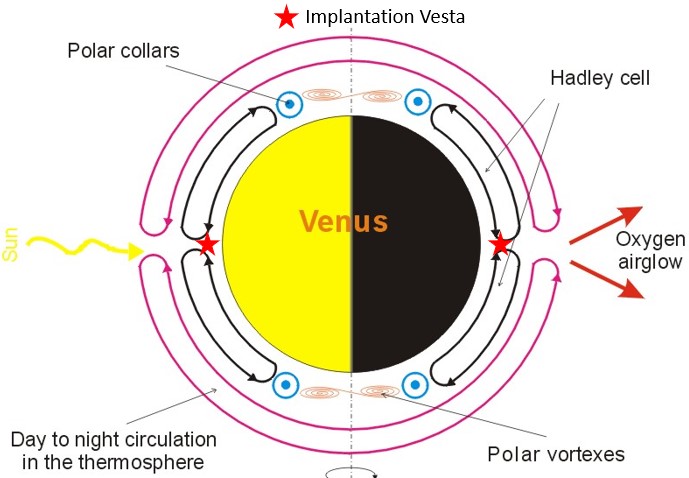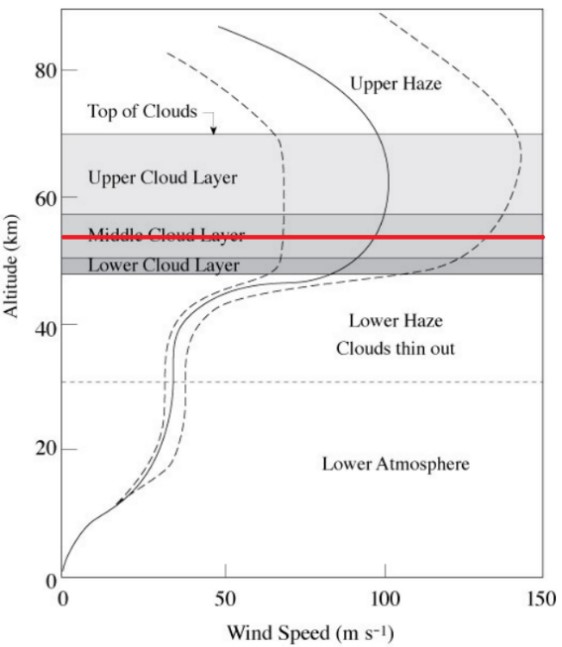For for clarity, the time will be expressed in 24-hour earth days and 584-day alignment periods, which corresponds to the time between two Venus’ passages between the Earth and the sun. The date is defined as the day of the alignment during which the first crew will depart, the the space of the various elements and the launch of the crew will be at negative dates.
This paragraph brings together the explanations of some of the mission’s structuring choices.
Mission time: a synod period
– The use of two successive windows for the return and the return allows an optimal mission duration/consumption ratio.
– It is possible to use more tense trajectories to reduce the duration of the but at the cost of an increase in transit time (hard psychologically and without much scientific interest) and/or consumerism propellants.
– A mission on several alignments would have too much psychological weight at first.
Crew size: 6 members
– A crew would add too much weight to the mission.
– With the need to double skills (at least technical and medical), a smaller crew would leave less room for diversity of skills Scientific.
– With a large crew, the variety of interpersonal interactions and the the possibility of reartiling the group around several nuclei allows reduce psychological pressure in the event of temporary tension between two Members.
– In the assumption of an international partnership, a large crew provides more seats in negotiations with member agencies.
– Size the project for a crew of 6 gives a design margin by allowing a further reduction.

Design earth launcher: Ariane 6
– By this choice, it is not to be meant that the project is based solely on Ariane 6, but it serves as a standard value.
– It is substitutable for the current similar-sized launcher or 1 to 1 (Atlas 5, Delta IV, Vulcan, Reusable Falcon Heavy, Proton, Angara 5, CZ-5 or a completely new launcher) or by heavy launchers for simple launches instead of paired launch (Falcon Heavy New Glenn, CZ-9).
– Using medium-range launchers increases the number of shots, but the most are commercial launchers whose launch price per kg is optimized compared to the SLS super-heavy launcher.
– This avoids the development of a giant launcher like the BFR.
– In the context of international cooperation, the proliferation of simplifies the division of tasks and allows each partner to do not give the impression of being added to the one with a heavy launcher.
– With a large number of guaranteed shots, it will be possible to have economies of scale on selected launchers, to reduce shooting prices to make the most of the improvements and to free ourselves from the public subsidies.
– Some launchers will need to be certified for manned flight, which is not the case without heavy modification for Ariane 6.
Location point: 54 km above the equator of Venus
– An implantation at the Venusian equator allows the atmospheric convection movement to be used to bring back to the base the payloads that have drifted north or south.

– At this time altitude, the pressure is 0.638 atm (equivalent to 3500 m altitude on Earth), this is livable (city of La Paz) without having to pressurize the habitat. however because a large part of the crew is unlikely to come from areas of mountain, it would be interesting to pass the proportion of O2 from 21% as 33% to maintain the same partial oxygen pressure as in the sea level.
– The temperature of 36.6°C is livable, albeit uncomfortable, but a low temperature insulation and air conditioning achieve acceptable values.
– The presence of clouds of sulphuric acid allows large amounts of water to be recovered. Alone or combined with atmospheric CO2, it can produce propellants in situ. On the other hand, all the exterior surfaces of the base must be covered with PTFE (better known as Teflon®).
– With clouds above and proximity to the sun, solar energy received directly from the base is important (in the order of 1750 W/m2). In addition, thick fogs below return a significant amount of and allow for omnidirectional lighting.
– Even if air is a less effective anti-radiation barrier than a solid or 100 km of CO2 above the base (and especially the last of the denser km) protect the crew from solar and cosmic radiation without need extra armour or planetary magnetism. This phenomenon atmospheric absorption results in a more in particular, the doses of radiation suffered by airliner crews 10 km above the rest of the population.
– With a wind average of 86.6 m/s, the base completes a complete tour of the planet in 5.04 days limiting the period of darkness to 60 hours.
– The fact that the base revolves around the planet allows you to quickly reach a large variety of land. A stand-alone exploration system will be required to reach other latitudes.
